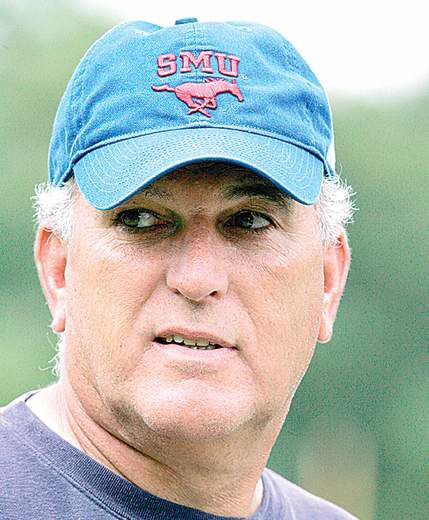June Jones starts over again
Published 5:00 am Saturday, August 16, 2008

- SMU quarterbacks will set new records, June Jones says.
DALLAS — June Jones pulls out a digital camera from his desk drawer and shows off the million-dollar view from his condominium in Hawaii: Kahala Beach to one side and the volcanic crater of Diamond Head to the other.
“Not bad,” Jones said.
Nearly eight months after surprising the college football world by leaving Hawaii to coach Southern Methodist University, Jones doesn’t have any pretty pictures of smoggy Dallas. The football view pales, too.
Hawaii was 12-1 last year, the biggest sports show in Honolulu. SMU was 1-11, which doesn’t matter because Dallas stopped caring a long time ago.
Yet Jones, the patron coach of lost causes, is exactly where he wants to be: hoping to revive a dying program, spreading the gospel of the run-and-shoot offense, trying to work another football miracle.
“I wanted another opportunity … to get another situation turned around,” Jones said. “Opportunity presents itself at these type of places.”
If the programs at SMU and Hawaii have anything in common, it’s that both were dreadful before Jones. He came to Hawaii after a winless 1998 season that was preceded by four more losing records. His first team went 9-4, the biggest one-season turnaround in NCAA history.
The Mustangs have 15 wins in their past five seasons, including an 0-12 campaign in 2003.
A former national power, SMU is in a two-decade swoon since the NCAA shut down the program in 1987 and the school canceled the 1988 season for paying players and breaking rules.
There’s been one winning season since, 6-5 in 1997.
“He always likes the biggest challenge,” said Portland State coach Jerry Glanville, Jones’ longtime defensive collaborator. “That’s the fun for him.”
The average announced attendance at SMU home games last season was about 17,000, one measure of the team’s irrelevance. In terms of interest and coverage in Dallas, SMU lags behind the city’s four major pro sports teams as well as the Longhorns, Aggies and perhaps even the Oklahoma Sooners, located 170 miles north.
SMU icon and college football analyst Craig James, a running back during the team’s tainted glory days of the early 1980s, said his football-playing son had “zero interest” in SMU and went west to Texas Tech.
“There’s an entire generation of kids who have no idea SMU used to be a good football program,” James said.
That’s what convinced Jones to trade in his leis for another long shot, the latest in a career full of tall orders. Jones attended four colleges and scraped out a professional career as a free-agent quarterback in the NFL and USFL.
Jones is not a coach from central casting. He runs a loose, relaxed operation.
He practically lets his defensive assistants run a separate operation and gives second chances to players with criminal records.
The latter was a mutually beneficial arrangement at Hawaii, allowing him to accept players such as record-setting quarterback Colt Brennan after he was kicked off the team at Colorado for his involvement in a burglary case that led to a criminal conviction.
Then there’s Jones’ beloved offense, the run and shoot, derided by critics as “some kind of backyard, flippety-dip” system, said Mouse Davis, Jones’ coaching mentor. Davis popularized the system at Portland State, where he made Jones his quarterback in the 1970s.
“People were saying we were heretics or stupid or all of the above,” said Davis, an offensive coordinator under Jones at Hawaii and now in the same job at Portland State. “June knew this is the way the game should be played. It gives you a chance to win on every snap.”
Jones calls the run and shoot an equalizer and the key to the Hawaii turnaround. Quarterbacks Timmy Chang and Brennan set NCAA records for career yards, career passing touchdowns and single-season passing touchdowns. Hawaii led the nation in scoring the past two seasons, and total offense and passing yards in 2006.
Jones is reusing practice scripts from 1999, when he introduced his offense to the Warriors. He confidently predicts his SMU quarterbacks will “reset the records books.”
He also makes no secret he expects to win at SMU. The Mustangs’ skill position players are faster than what he had his first year at Hawaii, Jones said. And recruiting players to Dallas from talent-rich Texas high school programs is proving an easy sell.
“If we were recruiting a kid (to Hawaii) who was being recruited by a Pac-10 school, we were probably 1 for 150 on those kids,” Jones said. “Here, before I even played a football game, I had 14 commitments of top high school kids for the ’09 season already. That’s the biggest difference.”
Maybe that’s why the view in Dallas seems fine to Jones, who calls his new gig “a tremendous opportunity in a great city.”
“June will fix it,” Glanville said. “Whatever is broken, he will fix it.”






